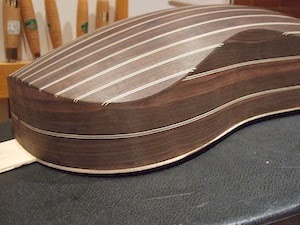I re-shaped the lower portion of the mould so that the vault was a little more pronounced in the problem area. The rib lines of the last three ribs were almost straight as you can see on the vaulted back on the left. The corresponding ribs on the new back (top right-hand corner of the photo) show a definite curve that strengthens the vault.
 |
| Guitar body before making the changes |
While I was building the new back I was also thinking about inlaying a triple fillet into the side ribs. I had considered this before I started building the guitar but I couldn't figure out how to do it. Baroque guitar sides are usually assembled from multiple strips glued edge to edge forming the necessary height and then bent to the proper contour. Had I followed that procedure the result would have been side ribs with odd wavy inlaid lines because the ribs are not perpendicular to the soundboard but are angled in from the down towards the back.
Letting an idea ferment for a while can yield results. I suddenly had the idea of combining the principles of a marking gauge and a veining tool into one and cutting the groove for the inlay right into the finished sides of the guitar. The idea was to scribe two parallel lines, 2 mm apart, into each side of the guitar and then to scrape or gouge out the material between the lines. The procedure would require multiple passes, cutting deeper into the wood with each pass, so firmness of touch and complete stability of the tool and guitar were essential.
I cut a piece of 2 mm thick tool steel, ground a knife edge single bevel on one end and a slightly angled but blunt scraping edge on the other end and tempered both ends. The cutting tool was mounted in a simple, but precisely made wooden block.
In order to provide stability to the guitar body, I glued a close fitting temporary front into the body and levelled the side ribs on a sanding board. Working on a flat surface, I held the guitar firmly under my fore-arm and pressing the scribing tool block against the flat work board I drew the tool from one end of the guitar to the other, multiple times. The second parallel line was cut by flipping the blade in the tool holder and repeating the process.
Once I was satisfied with the depth of the parallel lines I fixed the blunt scraping end of the tool in the wood holder. Although I took photos of the cutting and scraping process I can't find them. They must have vaporized.
The side ribs are only 1.2 mm thick so I was worried that the pressure of the scraping tool would cause the rib to bow and subsequently throw the tool out of line, ruining the groove.
But all went well, although I did scrape through the side ribs in several places, and after test fitting I was able to glue the first fillet in place. In the areas where I installed the fillets I papered the inside of the ribs when all was finished.
I liked the results and so much and since I was confident in the method I decided to add a second fillet. I made an extender block of the necessary height and screwed it to the bottom of my tool holder. Installing the second fillet went as smoothly as the first.
I am well along in assembling the neck and peghead with their unique veneer design. As soon as I have glued the neck to the body I'll report on my work again. In the meantime here are several photos of the Checchucci guitar to date.









The thought was to recorder two parallel lines, 2 mm separated, into every side of the guitar and after that to rub or gouge out the material between the lines. The methodology flame cutting might require various passes, cutting deeper into the wood with each one pass, so immovability of touch and finish strength of the apparatus and guitar were fundamental.
ReplyDelete